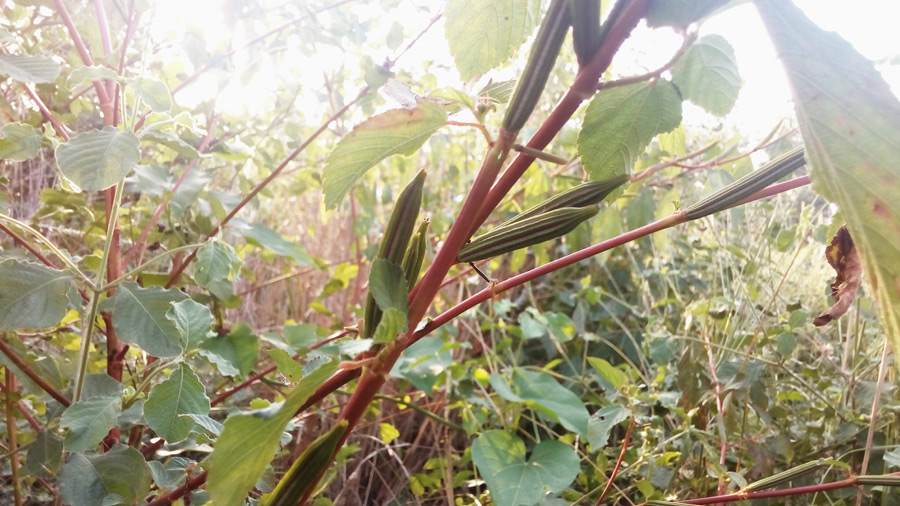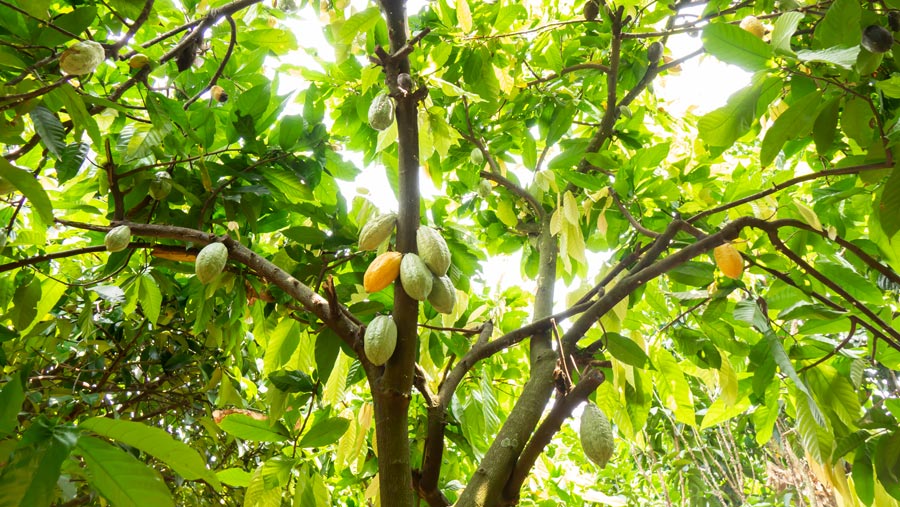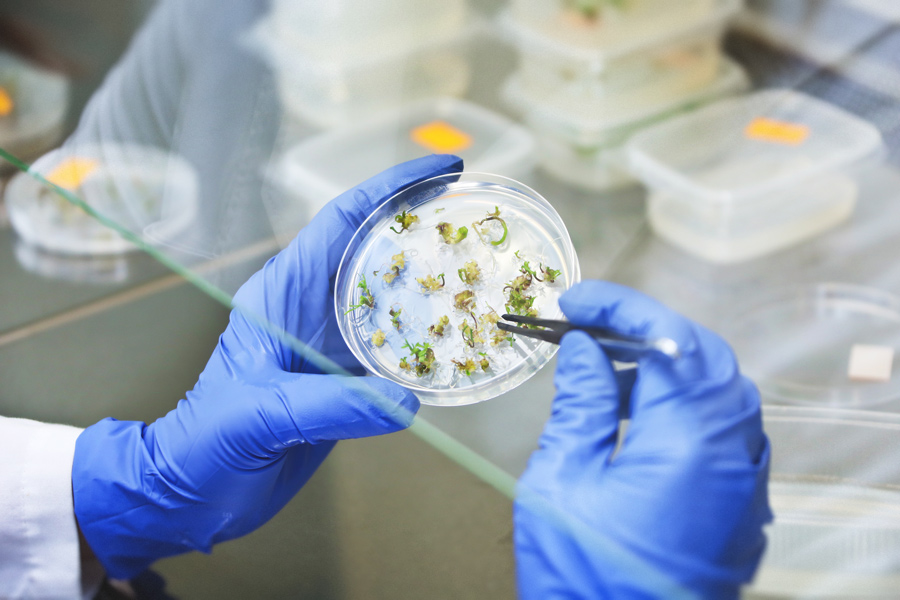Transcription factors regulate stress resistance in jute
Dark jute is an increasingly valued bast fibre-yielding plant with a diversity of uses. However, there is a need for varieties that can tolerate challenging environmental conditions. Scientists of Basic and Applied Research on Jute Project at the Bangladesh Jute Research Institute used molecular genetics methods to study the role of the transcription factor superfamily AP2/ERF in the adaptation of jute to environmental stresses (waterlogging, drought, salinity and fungal infection) towards developing stress-resistant varieties. They also uncovered the phylogenetic relationship, evolution and gene expression of the AP2/ERF gene family in dark jute.
Native to the Indian subcontinent, jute is the most valued bast (stem) fibre-producing plant in the world and the second most widely grown and used natural fibre after cotton. Of the two cultivated jute species – white jute (Corchorus capsularis) and dark jute (C. olitorius) – dark jute is preferred, being stronger, softer and silkier. Until recently, jute fibre was mostly used for packaging but, with diversification of jute products, demand for it has grown. It is also increasingly valued as an ecofriendly, biodegradable and renewable product.
However, jute yields are seriously reduced by biotic factors (~30% loss from soil-borne fungal pathogen Macrophomina phaseolina) and by abiotic stresses (such as waterlogging, drought and salinity). With an ever-increasing demand for land suited to food crops, jute cultivation is being pushed to marginal land. Varieties that can survive harsh growing conditions are therefore needed.


The development of stress-tolerant varieties of jute by traditional hybrid breeding has been limited because of cross-incompatibility between different populations of plants. Although genetic engineering methods offer an alternative breeding method, understanding the specific roles of useful gene families and the regulation of responses to environmental stress in jute comes first. Researchers at the Basic and Applied Research on Jute (BARJ) Project under the leadership of Professor Maqsudul Alam team at the Bangladesh Jute Research Institute set out to detect, characterise and conduct functional analysis on a transcription factor superfamily to see if it has promise.
Transcription factors in plant stress responses
Several transcription factors (TFs) – proteins involved in the stress responses of plants – have been well-characterised. They regulate gene expression through specific binding to cis-acting elements (regions of non-coding DNA) in the promoters of their target genes. In this way, TFs turn genes on and off so that they are expressed in the right place at the right time and in the right amount throughout a plant’s life. Groups of TFs work in a coordinated way to direct growth, development and stress response in plants.
Evolutionary patterns show that dark jute separated from cacao and cotton 14 and 22 million years ago.
The transcription factor superfamily AP2/ERF has been investigated in various plant species. It was first identified as APETALA2 (AP2) of the experimental plant Arabidopsis and as tobacco ethylene-responsive factor (ERF). This superfamily has four subfamilies: AP2, RAV, ERF and DREB. Proteins in the DREB and ERF subfamilies are known to be involved in dehydration or ethylene responses. However, systematic investigation of this superfamily in jute has been lacking.

The researchers began by comparing genome and protein sequences from jute with AP2/ERF superfamily gene sequences and their corresponding protein sequences in the well-studied plant Arabidopsis. From this, 119 genes (CoAP2/ERF) in dark jute were identified as being members of the AP2/ERF superfamily.
A closer look at transcription factor superfamily AP2/ERF in jute
Existing knowledge of what each gene does (gene ontogeny) indicated that the 119 proteins produced by the CoAP2/ERF genes are involved in several biological processes, including regulation of transcription (synthesising messenger RNA from DNA). Studies of protein interactions in dark jute and Arabidopsis indicated that these proteins mostly participated in cold regulatory pathways and might also be involved in drought tolerance.

Three-week-old jute seedlings were subjected to waterlogging, fungal, drought and salt stress and then 45-day-old plants were used for tissue-specific expression analysis of the genes of interest. Expression of AP2/ERF genes during development and their role in stress were characterised using RNA-Seq, a sequencing technique for gene expression studies. RNA-Seq data from vegetative (leaf, bast fibre and stem) and reproductive (flower and fruit) development stages of jute were visualised using the heat map technique.
Expression profiling (measuring the activity of genes to give a global picture of their cellular function) revealed that 78 out of the 119 CoAP2/ERF genes identified were activated during stress in at least one plant organ. Their expressions were confirmed through quantitative real-time PCR analysis, a technique that monitors the amplification of a targeted DNA molecule. This revealed that, among the 78 activated genes, 3 showed increased activity in response to waterlogging and 3 had positive effects in plants under salinity and drought stress.

Using computer simulation to construct a model of the CoAP2/ERF protein from its amino acid sequence and an experimental three-dimensional structure of a related protein (homology modelling), the predicted structure of CoAP2/ERF was found to be consistent. Along with the protein-protein interaction network (mathematical representation of the physical contacts between proteins in the cell), this provided a foundation for studying the molecular regulation of these proteins.
The cis-regulatory elements found upstream of genes in the promoter regions and acting as binding sites for TFs have key roles in determining the tissue specificity and stress-responsive gene expression. DREB genes are more likely to regulate the stress response whereas the ERF subfamily is usually related to plant hormone regulation. In jute, three drought-stress, a cold-stress, a heat-stress, a saline-stress and a wound-stress cis-regulatory element were found in the promoter region of CoDREB genes.
Genes found for waterlogging, salinity and drought stress in jute could be explored in improving plant resistance.
The evolution of AP2/ERF genes in jute
Phylogenetic reconstruction of the conserved domain (a recurring unit) of AP2/ERF helped to determine the evolutionary relationship of CoAP2/ERF genes. A phylogenetic tree was constructed with the 119 genes from jute and 147 AP2/ERF genes from Arabidopsis. These were clustered into clades or groupings having common ancestors. Further analysis divided the ERF-type clade into ten subclades matching previous gene classification in Arabidopsis. Four of these subclades were in the DREB subfamily and six in the ERF subfamily.

Gene duplication in organisms produces genetic diversity that can also lead to functional divergence. Tandem duplication makes gene clusters and segmental duplication makes homologous genes that eventually expand the gene family. Expression profiling of duplicated genes can provide information about their function. In this study on jute, duplication analysis found three tandem and eight segmental duplications arising from ancient duplication events. Apparently, the functions of these superfamily genes have been expanded and enhanced over time.
To identify the evolutionary patterns of CoAP2/ERF genes, comparative orthologous analysis (looking for genes diverged after a speciation event) was performed among three species in the family Malvaceae – dark jute, a species of cotton (G. raimondii) and cacao (Theobroma cacao). The results showed that dark jute separated from cacao and cotton 14 and 22 million years ago, respectively.
In summary, these results help to classify this potentially useful gene family and provide insight into the evolution of AP2/ERF genes. The researchers have also identified some candidate genes for waterlogging, salinity and drought stress in jute that could be explored in improving plant resistance.

Personal Response
Would you like to add anything about hormone response for this supergene family in jute?
AP2/ERF transcription factors are involved in hormone signalling and hormone mediated-stress responses. Abiotic stresses are normally triggered by plant hormones, which activate a variety of physiological processes. Abscisic acid and ethylene are important stress hormones that are produced in response to abiotic stress and regulate AP2/ERF-mediated stress responses. Similarly some AP2/ERFs are associated in growth and developmental processes mediated by gibberellins, cytokinins and brassinosteroids hormone. Thus, the AP2/ERF family of transcription factors have emerged as key regulators of several abiotic stresses and respond to multiple hormones. However, the role of AP2/ERF genes in regulating plant hormone signalling in dark is still unknown and is a key area of future research.